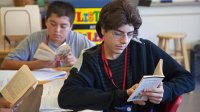Connecting Content to Students’ Lives to Boost Engagement
To effectively collaborate and problem-solve, students need to develop a greater understanding of themselves and others.
Your content has been saved!
Go to My Saved Content.As more students return to in-person school in the near future, it seems wise to invest our time and energy on strategies to increase student engagement that work both virtually and in person. Like all of us, students are most engaged when their work honors their experiences, connects to their interests, and has the potential to lead them to improvement of themselves, their lives, and issues that matter to them. Teachers can increase student engagement by re-envisioning their curricula in the following ways.
Identity and Criticality
Dr. Gholdy Muhammad advocates that teachers engage students by giving equal consideration to what she terms identity and criticality, in addition to building knowledge and teaching skills. Muhammad suggests that teachers promote identity work by asking themselves, “How does my teaching and learning help students learn about themselves and others?” Teachers can encourage criticality by asking themselves, “How does my teaching and learning help students to understand power, equity, antiracism, and anti-oppression?”
Curriculum that's culturally responsive and grounded in identity work is relevant and engaging, as it helps students better understand not only their own history and truth but those of others. Students can read and analyze class texts with the purpose of learning about other people’s lives, joys, and struggles as a way to build empathy for those around the world who may be (or may just seem to be) very different than they are. Muhammad stresses that in order to interact, collaborate, and problem-solve peacefully with different kinds of people, students need to develop a greater understanding of themselves and others.
Criticality engages students because it involves deep and analytical thinking that enables them to recognize their own strengths as they learn where they are positioned in terms of power and privilege. Students can begin to develop criticality by reading, watching, and examining social justice issues from a variety of perspectives, and then process their thinking through written reflection and classroom discussions. This deeper understanding of societal norms and the resulting inequities fosters agency for the students as they begin to identify how they can effect change and disrupt unfair policies and systems.
Mirrors, Windows, and Sliding Glass Doors
Academic pursuits should offer students the opportunity to see their image reflected back in their coursework as they also peek through windows to see what’s possible and envision sliding glass doors to walk through toward greater opportunities. As educator Rudine Sims Bishop writes, “Reading, then, becomes a means of self-affirmation, and readers often seek their mirrors in books.” Student engagement increases when school affirms their realities and the work they do connects to their lives.
Teachers and schools can begin by diversifying curricula to include texts that offer students the opportunity to see themselves in the books they read and glimpse worlds that depict people who look like them, who are accomplishing things they may never have thought possible. Teachers can offer opportunities for students to gain knowledge and practice skills while they engage in the practical application of real-world skills that matter. Then, students can metaphorically walk through doors on their own path by sharing their voice through slam poetry and podcasts, and their writing, art, and photography in blogs and contests.
Inquiry and Urgency
Students are even more likely to engage in culturally responsive classrooms when they consistently approach content in a spirit of curiosity and inquiry. Begin lessons by asking students questions like “What do you know?” “What do you think you know?” and “What do you want to know?” In a language arts class, an inquiry-based approach might ask students in a Think, Pair, Share to consider minor characters in a novel with questions like “Which characters would you identify as minor characters? What is their gender, role, socioeconomic status? Do they have any power? If so, over what or whom? What purpose do they serve in the novel? Why do you think the author didn’t give them very much dialogue? What might this say about society at the time of the novel?
In other content areas, photographs can stimulate inquiry by motivating students to ask what they see, think, or wonder as they discuss observations of images across the globe that depict discrimination, economic instability, food insecurity, climate crises, public health issues, and other social injustices. Teachers can then recognize students’ observations and raise this sense of urgency by asking students to think more broadly, with questions like “What are the consequences of...?” “What else does this connect to?” “Why is this significant?” and the ever-important “What can we do about it?” as students recognize themselves as change agents who can make an impact.
When teachers approach learning experiences with a willingness to learn and grow from what students bring to the conversation, we can introduce our knowledge and experience to elevate the conversation and promote student agency. In a classroom where students feel safe and valued, they can engage with confidence in all facets of inquiry driven by the understanding that their voices matter and it's in their power to improve their lives and the lives of others.
